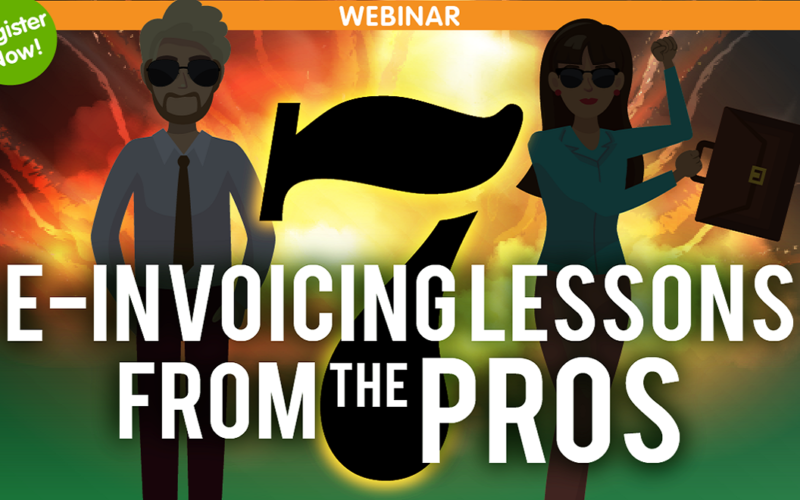7 invoicing tips from e-invoicing pros

E-invoicing is a no-brainer for today’s finance organisations. But with so much to gain from adapting invoicing processes, how can finance leaders be sure they’re making the most of their new solutions? In this article, we’ve drawn together top invoicing tips from trailblazing user Dave Huddart, Global Process Owner at Oracle.
Invoicing tips: The goals of e-invoicing
The best e-invoicing solutions can solve some of the major challenges that finance functions face when processing payments. According to Huddart, getting the most out of e-invoicing solutions depends on setting goals with the following outcomes in mind:
- Streamlined supplier experience
- Faster, reliable invoice delivery
- Improved AP processing efficiency
- Prompter payments
- Fewer support tickets
Oracle processes a total of 850,000 supplier invoices annually, representing $3 bn (USD) of intercompany payments value. Huddart noted the company doesn’t count PDFs, as they still require a substantial amount of manual processing. Instead, Oracle has three categories for their e-invoicing.
What does Oracle classify as e-invoicing?
Huddart defined the three types of e-invoicing as:
- B2B messaging: Electronic messages sent between ERPs (Enterprise Resource Planning)
- Supplier Portal Entry: Invoices submitted via a supplier portal
- Intercompany: Automated transactions between Oracle entities.
Emailed invoices are not included. In the 38 countries where e-invoices are accepted, Oracle electronically processes 83% of the total number raised. Of the total number of supplier invoices processed, around 650,000 are done electronically.
So, what advice did Huddart have for finance leaders hoping to transition substantially to e-invoice? Let’s take a look at his top invoicing tips below.
Top 7 invoicing tips from a pro user
1. Be process ready
According to Huddart, there are several actions finance leaders must take to prepare effectively for a transition to e-invoicing. You should ensure you have high PO (purchase order) adherence, as matching transactions to POs provides greater security for transactions and guarantees the right amounts are quoted.
Exception handling workflows should be thought through ahead of time. For Oracle, that means ensuring that there are robust processes in place to make exception handling as streamlined as possible. In a similar way, automating tax is key, so it’s important to establish a mechanism for assigning values to tax codes.
Huddart also offered advice on data enrichment in process readiness. Watch the full webinar here to discover his full range of e-invoicing tips for free.
2. Focus on internal buy-in
Involve all stakeholders and keep the benefits very clear. Procurement stakeholders, in particular, must understand the benefits if the e-invoicing rollout is to be a success. Keep communication consistent and constant, as people change roles often across the company. Don’t forget to develop internal communications to loop in the entire business.
3. Get a solid project framework
Approach and scope. Know which countries and suppliers you’re targeting for an e-invoicing rollout. It’s also beneficial to establish a systematic onboarding process you can train finance teams to use. Keep momentum going with a regular review of invoice volume to account for supplier churn.
4. Create strong onboarding processes
Accurate supplier data, segmentation and effective communications are all critical to the success of your e-invoicing rollout. It’s best to onboard your suppliers at the start of your relationship if possible, as Hubbart notes that is when they will be keen to impress and most receptive to new processes.
5. Make it easy
E-invoicing needs to be painless and cost effective. Supporting multiple formats, connection protocols and providing rejection feedback help to make the process as straightforward for suppliers, even when payments aren’t successful.
It’s also worth noting that your solution shouldn’t cost more than paper invoicing. One of the main goals of e-invoicing is to save everyone money, after all.
Huddart also offered advice on data enrichment in process readiness. Watch the full webinar here to discover his full range of e-invoicing tips for free.
6. Value compliance
Compliance is an essential part of setting up any new process and e-invoicing is no exception. Huddart confirmed that with e-invoicing, it’s all about keeping a compliance mindset from the start of the project.
It’s critical to have a roadmap of when compliance rules will change, especially in relation to international e-invoicing mandates. Oracle avoids getting paralysed with compliance concerns by ensuring that their solution meets the criteria on the launch date. From there, Hubbart ensures that they automate processes to reduce the resources necessary to maintain compliance.
7. Track success
Using KPIs based strongly around the desired goals of e-invoicing we discussed earlier, Hubbart says it’s essential for finance leaders to track their success. Oracle also tracks the comparative processing efforts of manual versus e-invoicing activities.
It’s also important to regularly report outwards to senior executives, showcasing the main KPIs and how each of them are being met by the new processes. A good place to start is to compare the costs and time saved by e-invoicing.
Watch the full webinar for free with Tungsten Network
Tungsten Network brings experts from across the finance space to discuss how they’ve benefited from rolling out e-invoicing in their businesses.
Find out more by watching the full webinar for free.



